Working towards a reconstruction of Johannes Vermeer's home at
the Oude Langendijk, Delft
3D-reconstructions made by industrial designer ing. Allan
Kuiper based upon reconstruction drawings by dr.ing. Henk J.
Zantkuijl in this project
developed by art historian drs. Kees
Kaldenbach,
 Johannes
Vermeer and his family lived in a spacious house at Oude Langendijk
on the corner of the Molenport/Jozefstraat alleyway, from 1660
onwards, or perhaps even earlier. Some fifteen years later at the
time of his death in December 1675, Vermeer left a relatively modest
estate. In the beginning of 1676, within the legally proscribed term
of three months, the inventory was listed by a clerk working for
Notary public. Due to an
outstanding debt which was unpaid, Vermeer's trade stock of paintings
by other masters was left out of this inventory.
Johannes
Vermeer and his family lived in a spacious house at Oude Langendijk
on the corner of the Molenport/Jozefstraat alleyway, from 1660
onwards, or perhaps even earlier. Some fifteen years later at the
time of his death in December 1675, Vermeer left a relatively modest
estate. In the beginning of 1676, within the legally proscribed term
of three months, the inventory was listed by a clerk working for
Notary public. Due to an
outstanding debt which was unpaid, Vermeer's trade stock of paintings
by other masters was left out of this inventory.
In 1957 Van Peer, a Delft inhabitant who had undertaken extensive
research on Delft city history in archives, published this Vermeer
inventory in full in the art history magazine Oud Holland. In
this inventary are not only a wonderful list of objects which are
described, but also the names of the various rooms which contained
these items as well. This allows us to take a mental walk around the
house, from the forehouse to the Great Hall and the various kitchens,
to end in the studio which was located at the front of the building
on the upstairs floor. Details on how these rooms were positioned
were not avilable, and so until 2001 no serious reconstruction
drawing had been attempted (see note 4).
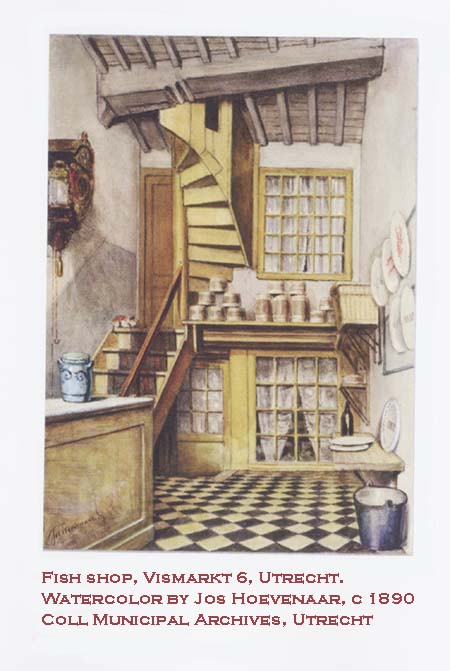 Lost 17th century
interiors
Lost 17th century
interiors
Although in The Netherlands a remarkable number of seventeenth
century facades have been handed down to us, the state of
conservation of the interiors and architectural woodwork behind the
facades is often less wonderful. No single 17th century interior of a
family home has been conserved in prime condition as far as woodwork,
separation walls, stairs, chimneys, kitchens and bedsteads are
concerned. However, during the last decades expertise in the field of
17th century homes has increased dramatically.
This knowledge is now displayed in two historical heritage sites
in Amsterdam. The living quarters of the hidden Roman Catholic church
'Onze Lieve heer op Solder' (Our Beloved Lord in the Attic) has
have remained close to their original state, and the current
historically correct furniture and objects evoke the spirit of that
era. Due to the increased expertise, not only in the field of
architectural restoration but also in several other scientific
disciplines, the Rembrandt House has recently been restored
back to an image of its 17th century state. This museum is now richly
filled with the type of objects which were once collected by
Rembrandt; objects listed for the auction of his belongings
necessitated by his bankruptcy. Within Rembrandt's studio one can now
also admire a painter's easel and painter's supplies. There is a
fragrance of painter's canvas and linseed oil.
Thanks to this increased knowledge, it is now possible to present
an architectural presentation of Vermeer's home at Oude Langendijk in
Delft. For this internet presentation a set of drawings was prepared
by the engineer dr. Henk J. Zantkuijl, formerly Associate Professor
of building engineering at Delft Technical University. This set of
drawings is presented here for the first time, along with his
technical account of his
method.
In Zantkuijl's drawings all rooms mentioned in the Vermeer
inventory have been indicated with letters.; for example,"L" marks
Vermeer's relatively small painter's studio on the upstairs floor,
overlooking the road and water of Oude Langendijk canal. Based upon
those detailed floor plans, industrial designer Allan Kuiper then
crafted a 3D model from which here a number of stills and an
Internet movie are shown.
Illusionism
Vermeer's paintings of interiors show a level of 'illusionism'
which is unparallelled given the high artistic levels in his days.
The question of whether his paintings depict existing spaces -
perhaps even rooms in Vermeer's own
house , occurs to the viewer repeatedly. In expertly applying his
incredible sense of perspective and colour, Vermeer places each human
figure in a clearly defined space created in which daylight nearly
always streams in from the left side. By closely observing and
analyzing these details, one can come to particular assumptions and
conclusions concerning the rooms and objects.
However, in the paintings we do not see images from Vermeer's
"photo album". The garments of the figures and their actions are not
of the everyday kind. With a few notable exceptions, Vermeer presents
extremely well dressed upper class, 'juffers en jonkers'
(young ladies and gentlemen) who are portrayed in a moment of silent
introspection; reading, writing, weighing, surrounded by refined and
costly objects. Vermeer lived, not in a world of high society and
nobility, but in circles of well-trained Guild craftsmen. Thus when
he depicts juffers en jonkers' in his refined interiors, then
he shows us artistic constructions, another, remote reality.
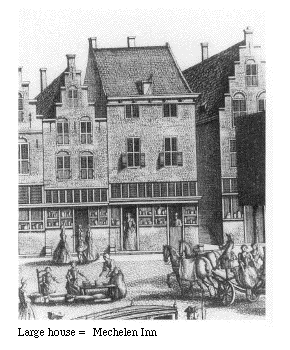 Family
life
Family
life
After his marriage in 1653 to Catharina Bolnes (ca. 1631-1688)
Johannes Vermeer (1632-1675) may have lived for a while in the large
parental mansion 'Mechelen' on market square, but finally the married
couple came to stay in the Thins/Vermeer home, at the north-eastern
corner of Oude Langendijk canal and Molenpoort gate. We do not know
for certain from which moment the newlyweds Catherina and Johannes
came to join Maria Thins/Bolnes (Catherina's mother, who lived from
ca. 1593-1680). The first document pinpointing the married couple as
living at that address is 27 December 1660.
Many years before, Vermeer's mother in law had separated from
Reynier Bolnes (d. 1673) after a particularly bad marriage.
At the separation she successfully claimed her fair share of the
property. Especially the land holdings made her a well-off woman. She
left Gouda and moved to Delft into the house which had been bought
one year earlier by her brother Jan Thins.
 In
1653 her daughter Catharine Bolnes married Johannes Vermeer. Due to
this marriage the painter, himself son of a silk-satin
(caffa)-weaver, inn keeper and tradesman in painting has risen
very fast from a class of lower artisans to the social and financial
middle strata of Delft urban society. Vermeer researcher and author
John Michael Montias has made an estimate of the combined annual
income in the Thins/Vermeer family, which squarely puts this family
in the urban middle class.
In
1653 her daughter Catharine Bolnes married Johannes Vermeer. Due to
this marriage the painter, himself son of a silk-satin
(caffa)-weaver, inn keeper and tradesman in painting has risen
very fast from a class of lower artisans to the social and financial
middle strata of Delft urban society. Vermeer researcher and author
John Michael Montias has made an estimate of the combined annual
income in the Thins/Vermeer family, which squarely puts this family
in the urban middle class.
Vermeer paintings show little of the bustling of the busy family
life of his large nuclear family. On a day-to-day basis Catherina
Bolnes must have been very busy with her practical and domestic
affairs. Assisted by a maid, she took care of the children, ans she
must have knit, sewed, washed and mended clothes, also every day she
cooked and kept the household in good order. She became pregnant a
great number of times. In 1676, when Catherina Bolnes just turned
widow, she had eleven living children. Given the number of
burial entries we know that since her wedding day in 1653 she had
given birth to a total of fifteen
children, four of which died young. This total number of births
and this number of children surviving was exceptionally high within
the Republic of the United Provinces. Here, in circles of artisans
and the urban middle class a family with two or three children was
considered normal. (See my chapter on midwives and childbirth
in the seventeenth century). Despite the more than reasonable income
in the Thins-Vermeer home, actually feeding so many mouths and
clothing all of these growing children must have been a formidable
task.
Scenes of refined young women and men in meditative poses were thus not part
of daily life. The lower female servants are known from a few details of paintings
only. Regarding the Milkmaid one may however think of the maid Tanneke Everpoel
who lived in the Thins/Vermeer house for a number of years.
Vermeer's total oeuvre of about 35 paintings may be well
taken in totally and by the sheer visual force it invites close
looking and comparing. In the course of time one recognizes recurring
items such as chairs, garments, tapesties,
paintings-shown-within-paintings, pearls and some other objects can
be recognized in a number of sizes and varieties. A number of authors
of books and articles about Vermeer wished to recognize Vermeer's own
house at Oude Langendijk in Delft, mentally reconstructing it. This
very house which was purchased by Jan Thins, brother of Maria Thins,
will be referred to on this web site as the Thins/Vermeer house.
Reconstruction 1950
The author P.T.A. Swillens has reproduced a number of his
reconstruction drawings in his book 1950 book on Vermeer. Starting
from a number of paintings he drew floor plans and elevations of a
number of interiors, all hypothetically pointing to existing rooms.
He distinguishes five separate rooms, which he refers to as rooms A
to E, while stating that room A is shown in no less than eleven
separate paintings. Noticing how the light falls he also describes
how parts of the windows on the left side were blocked off by
shutters or sets of heavy curtains. Sizes were estimated by Swillens
by the assessed height of chairs and from that figure he calculated
the size of the floor with its pattern of light and dark marble or
earthenware floor tiles. Thus he came to present a series of
calculations and schematic representations of Vermeer's interiors.
However, Swillens lacked historical knowledge of domestic
architecture. He did not systematically take in to account the
position of ceiling beams and the visible thickness of the wall.
Neither did he understand the consequence of a visible or invisible
supporting wall next to the window. This last matter is of crucial
importance in assessing whether the window has been placed near the
corner of a facade wall or in an inner separation wall. The height of
the parapet (thus the wall from the floor to the window sill) is also
important. Swillens also failed to analyze the varied construction
types of windows.
Modern authors of recent exhibition catalogues and books on
Vermeer, including recent art history congress papers, have become
much more reticent in presenting drawings and elevations. This is
because experts now have a clearer sense of divergence between a
painting of a interior and the actual interiors. Sketching a possible
setup of a house is one thing but the margin of incertainty increases
when one tries to depict details within a reconstruction. Vermeer did
depict many variations in elements (such as maps and
paintings-within-paintings) of his seemingly photo-realist paintings.
From the 1960's onwards specialists became more convinced that
Vermeer paintings are not 'photographs' but painted reconstructions.
John Michael Montias reports this in 1989:
"If we assume, as I think we must, that Vermeer
represented more or less accurately the rooms and household
objects in his environment, we cannot but be struck by the way he
manipulated individual components of this reality to achieve his
ends." Montias, Vermeer and his
Milieu, p. 195.
Recently Philip Steadman published his book Vermeer's
Camera, Uncovering the truth behind the masterpieces (2001). In
it, he presents far-fetched hypotheses on Vermeer interiors, assuming
that Vermeer paintings are indeed almost like photographs. Steadman
supposes that Vermeer, within a studio seven meters wide at the front
of the Thins/Vermeer house, entered a separate dark room, a Camera
Obscura which he had built. There Vermeer would have done the
preparatory work for his paintings. At the end of this reconstruction
presentation it will become clear whether or not Steadman's
hypothesis are tenable.
A lack of expert knowledge concerning building engineering and
knowledge of historical architecture caused errors of assessment by
Swillens, Montias and Steadman. Montias, being the most productive
Vermeer researcher and is a prolific author of cutting edge
knowledge, assumed incorrectly that there were no less than 7 rooms
on the ground floor, among which the 'Great Hall'. Upstairs he
assumed - again incorrectly - one or more private rooms for Maria
Thins, the owner of the house. Montias rightly points out that her
personal objects including Vermeer's chief work 'The Art of Painting'
and her personal jewelry were missing:
they were not included in the 1676 inventory. How the separation of
goods - which stayed outside the inventory was done, either legally
or illegally, will probably never be known. As stated Vermeer's
commercial stock of paintings by other masters was kept out of this
inventory as well because of an outstanding debt.
This series of archival documents form the basis of the 2001
reconstruction by Zantkuijl of the Thins/Vermeer house.
1638. The Delft Municipal Archives keeps the Hearth Tax
Register ('Register van het Haardstedengeld'), which is a tax
levied by the States of Holland on the number of hearths in each
home. From the list of houses on Oude Langendijk we learn that the
number of hearths per house varied from 1 to 12 as shown in this
graph (note 1):
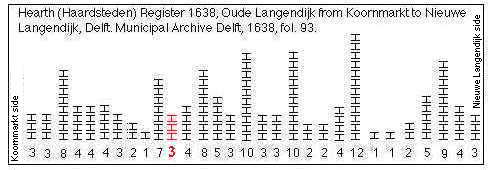
By combining various elements of evidence the Thins/Vermeer house
and those of his neighbours may be pinpointed as the
red one.
According to the tax register the Thins-Vermeer home had only
three hearths in 1638. Given the list of rooms in the 1676 inventory
a large annex or addition must have taken place after the year 1638:
the Great Hall was built and a set of back kitchens. The subsequent
building history is as follows:
1641. The house and yard of what we will call the
Thins/Vermeer home was purchased in 1641 by Jan Willemszoon Thins.
This was not Maria Thins's brother Jan but their cousin Jan Thins the
Elder. The purchase sum of 2400 Carolus guilders points at a house of
an appreciable size and quality, for a modest house could be bought
in Delft at that time for 600 to 800 guilders. The Thins/Vermeer
house was situated at the north eastern corner of Oude Langendijk and
an alley called Molenpoort (the present day Jozefstraat /
Jozefsteeg). This real estate was elongated and ended at a cross
alley at the intersection of the back yards of the Thins/Vermeer
house and the back yards of the houses facing Burgwal/Turfmarkt. It
is possible that in stead of a cross alley there were initially one
or more small houses within the Molenpoort. At the Oude Langendijk
end of this alley was a wooden gate which served to stop cattle which
had escaped from the Beestenmarkt. After Jan Thins' death this
Thins/Vermeer house was inherited by his two younger sisters Maria
and Cornelia Thins. (Note 2)
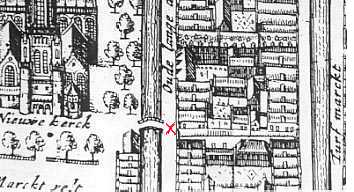 1649.
Plan of Delft, birds eye view by Blaeu. This map yields little
information on the Thins-Vermeer home, but we can get a rough idea of
the situation of this house. The preparatory drawing which served as
an image for the engraver could have been prepared prior to 1649.
1649.
Plan of Delft, birds eye view by Blaeu. This map yields little
information on the Thins-Vermeer home, but we can get a rough idea of
the situation of this house. The preparatory drawing which served as
an image for the engraver could have been prepared prior to 1649.
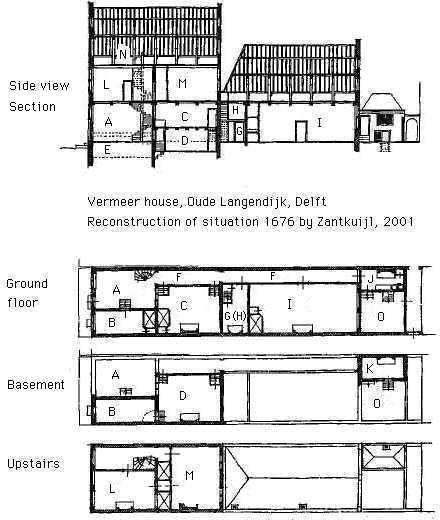 1676.
Inventory of household goods. This drawing by Zantkuijl, 2001,
follows the text of the Inventory of household goods and movable
goods, "huysraet ende meubile goederen" noted by an assistant
of notary public. In the Thins-Vermeer house this clerk noted the
following rooms. Letters refer to the reconstruction by
Zantkuijl.
1676.
Inventory of household goods. This drawing by Zantkuijl, 2001,
follows the text of the Inventory of household goods and movable
goods, "huysraet ende meubile goederen" noted by an assistant
of notary public. In the Thins-Vermeer house this clerk noted the
following rooms. Letters refer to the reconstruction by
Zantkuijl.
A. In the forehouse
B. on top of cellar room
C. inner kitchen
D. cooking kitchen
E. cellar
F. hallway
G. small room adjoining the great hall
H. little hanging room
I. great hall
J. back kitchen
K. washing kitchen
L. upstairs front room (studio)
M. upstairs back room
N. attic
O. the yard
To Zantkuijl's historical knowledge, bed steads, indicated on
these floor plans with an X are regularly positioned close to a
hearth and they are firmly attached to the timber and brick structure
of the house. They are not very long as those who use them sleep
sitting halfway up. Under the bedsteads, which are designed for two
adult persons, are a set of large drawers or "rolling coaches"
(Dutch: "rolkoetsen") in which children
could be stored away for the night. (see note 6) These spent the
night in somewhat claustrophobic spaces according to modern views.
The only bedstead without a hearth close by, according to Zantkuijl,
is that of the small room above the basement.
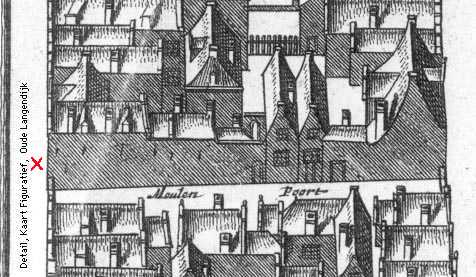 1678.
Fugurative Map (Dutch: "Kaart Figuratief"). A birds eye view of a
very large size, and of an exquisite quality, with fine detail. But
this map - just like that by Blaeu - has some limitations. It shows a
simplified impression. Within a given block between two side streets
a lesser number of houses has been depicted than the reality. But
given our present knowledge of archival material the architecture of
this Thins/Vermeer house has been carefully depicted.
1678.
Fugurative Map (Dutch: "Kaart Figuratief"). A birds eye view of a
very large size, and of an exquisite quality, with fine detail. But
this map - just like that by Blaeu - has some limitations. It shows a
simplified impression. Within a given block between two side streets
a lesser number of houses has been depicted than the reality. But
given our present knowledge of archival material the architecture of
this Thins/Vermeer house has been carefully depicted.
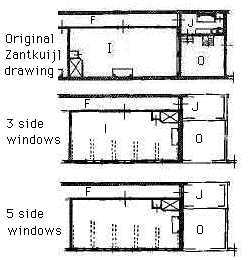 At
the Molenpoort alley we see a blind wall (a wall without windows)
with a number of wall anchors. From left to right, thus from north to
south, we see a succession of high to low building elements. At first
there is the original house, which has been dated by Zantkuijl as
sixteenth century, and next to it the annex containing the great
hall, built in the seventeenth century. Finally there are the lower
scullery buildings by the yard on the southern side. These buildings
elements have all been shown in the Zantkuijl reconstruction. The
lack or apparent lack of of windows on the alley side is remarkable.
There are a number of chimneys. If these are positioned accuretely by
the draughtsman and the engraver the very last chimney on the south
side would indicate that day light does not enter the great hall from
the southern wall but from a number of windows in the alley which
have erroneously been left out of this image. In order to allow this
alternative train of thinking to develop, Zantkuijl has also drawn
variant floor plans at my request: one variant with three windows and
a variant with five windows. The one with three windows does not work
well - given the spacing of the ceiling beams. However, Zantkuijl
feels that the initial lay out with a blind wall without windows is
the correct one. This would mean that the Great Hall was fairly
dark.
At
the Molenpoort alley we see a blind wall (a wall without windows)
with a number of wall anchors. From left to right, thus from north to
south, we see a succession of high to low building elements. At first
there is the original house, which has been dated by Zantkuijl as
sixteenth century, and next to it the annex containing the great
hall, built in the seventeenth century. Finally there are the lower
scullery buildings by the yard on the southern side. These buildings
elements have all been shown in the Zantkuijl reconstruction. The
lack or apparent lack of of windows on the alley side is remarkable.
There are a number of chimneys. If these are positioned accuretely by
the draughtsman and the engraver the very last chimney on the south
side would indicate that day light does not enter the great hall from
the southern wall but from a number of windows in the alley which
have erroneously been left out of this image. In order to allow this
alternative train of thinking to develop, Zantkuijl has also drawn
variant floor plans at my request: one variant with three windows and
a variant with five windows. The one with three windows does not work
well - given the spacing of the ceiling beams. However, Zantkuijl
feels that the initial lay out with a blind wall without windows is
the correct one. This would mean that the Great Hall was fairly
dark.
In 1676 this piece of real estate had a width of 6,70 meters and a
length of 32 meters (see the 1832 data). Given the total amount of
land between Oude Langendijk and Burgwal/Turfmarkt (see those canals
on the mas above and below) it is it hard to imagine that the two
transversal houses positioned within the alleyway at the word "Poort"
were really there. There is space for one on the 1832 map. Has the
other one been used to fill image space?
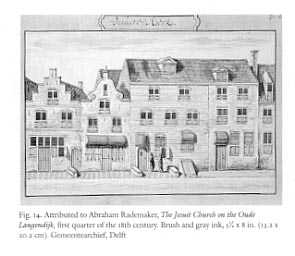 Circa
1700 ? Alas a drawing of the actual Thins/Vermeer house has not
come down to our time. In several recent publications a drawing by
Abraham Rademaker (1676/77-1735) showing the caption Jesuit church
("Jezuieten kerk") is interpreted as the Jesuit church on Oude
Langendijk canal. The exact spot on Oude Langendijk is not known to
us. The Thins/Vermeer home may be the one on the extreme right, but
may also be one or two houses over to the right, just outside the
scope of this drawing. What we can deduce from this drawing is a
series of modest houses, each one having a ground floor, an upstairs
floor, some with an extra floor, and an attic. The oddly shaped
curves above doors and windows cannot be explained here. Drawing in
Municipal Archives, Delft. Next to the Thins/Vermeer house was a
wooden gate closing off the alley. This gate kept cattle from
escaping the Burgwal/Turfmarkt catle market. Note 3.
Circa
1700 ? Alas a drawing of the actual Thins/Vermeer house has not
come down to our time. In several recent publications a drawing by
Abraham Rademaker (1676/77-1735) showing the caption Jesuit church
("Jezuieten kerk") is interpreted as the Jesuit church on Oude
Langendijk canal. The exact spot on Oude Langendijk is not known to
us. The Thins/Vermeer home may be the one on the extreme right, but
may also be one or two houses over to the right, just outside the
scope of this drawing. What we can deduce from this drawing is a
series of modest houses, each one having a ground floor, an upstairs
floor, some with an extra floor, and an attic. The oddly shaped
curves above doors and windows cannot be explained here. Drawing in
Municipal Archives, Delft. Next to the Thins/Vermeer house was a
wooden gate closing off the alley. This gate kept cattle from
escaping the Burgwal/Turfmarkt catle market. Note 3.
1733 or before. Demolition of the annex part (the Great
Hall and the scullery buildings at the back yard) of the
Vermeer/Thins house in order to make space for the new Roman Catholic
hidden church in the Molenpoort alley. See note
4.
 1832.
The first geographically sound map of Delft, called "Kadastrale
minuut" was published in 1832, in order to organize real estate
taxation in a professional way. (Note 5)
1832.
The first geographically sound map of Delft, called "Kadastrale
minuut" was published in 1832, in order to organize real estate
taxation in a professional way. (Note 5)
The Thins/Vermeer is indicated as a fairly short and wide house on
a piece of land of 6,70 meter wide and 12 to 13 meters long
(indicated here in orange). In 1832 the
Thins/vermeer house was owned by Nicolaas Scholtens. It then had a
registered surface of 0,0094 decimal acres ("hectare"). Clearly this
house was much shorter than the one of Vermeer's days (which was 6,70
meter by 32 meters), for the back section with the great hall has
been demolished. The piece of land which became available was sold to
one of the neighbours, who acquired a wide, probably walled garden
stretching along three houses. This broad garden is indicated in
black on this 1832 map.
In the back of each house along Oude Langendijk a piece of about 2
meters wide was retained in order to allow day light into the houses.
The real estate of the corner house seems to have a small extension
towards the back of the neighboring house.
In Vermeer's days the owner of the three houses towards the east
was Georgius van der Velde, who was the heir of Hendrick van de
Velde.
Conclusions and Propositions by Kaldenbach
 1)
In 2001 the Thins/Vermeer has been
reconstructed for the first time in a
sound manner by Zantkuijl, who based himself on a set of archival
information and professional knowledge of the building history of
domestic buildings in the sixteenth and seventeenth century Dutch
Republic. (see note 4)
1)
In 2001 the Thins/Vermeer has been
reconstructed for the first time in a
sound manner by Zantkuijl, who based himself on a set of archival
information and professional knowledge of the building history of
domestic buildings in the sixteenth and seventeenth century Dutch
Republic. (see note 4)
2) Vermeer painted his oil paintings in a relatively small studio
on the upstairs floor at the front of his house. Given the available
space there could not have been a large camera
obscura of the type in which Vermeer would have sat -
according to Steadman (2001). The alternatieve space for this
instrument would have been the great hall. This room does not fit
Steadman's bill because of the apparent lack of large windows.
3) Zantkuijl has noted a number of remarkable constructive
elements in Vermeer paintings, especially concerning the kinds of
windows, walls next to windows, and walls and parapets in general. If
Vermeer did paint existing rooms in his house, then
constructive conclusions can be reached.
Zantkuijl in his separate text has tried to link the reconstructed
interior of the Vermeer house and paintings by Vermeer. See Zantkuijl's
full explanatory text.
4) The 1676 inventory is both extensive and detailed. By
constructing a model of the Thins/Vermeer house with reproductions of
similar objects, it has now become possible, after many centuries, to
visit his house and studio of the great
painter. This digital historic house can be visited by clicking on
lists and by seeing internet
movies. These are made with a zero budget in money and time and
are thus not of Hollywood standard.
5) The reconstruction presented here presents a unique chance to
imagine the shape of a lost Vermeer
painting. The Hoet sale catalogue in Amsterdam, on 16 May 1696
mentions this painting as number 5: "In which a master washes his
hands, in a perspective room, with several human beings, artful and
rare, by Vermeer" - sold for 95 guilders.
("Daer een Seigneur zijn handen wast, in
een doorsiende kamer, met beelden, konstig en raer, van dito
[=Vermeer], f 95-0.") The word "beelden" refers to human
figures not statues according to dr. Albert Blankert (in a private
message, 2000). If this lost painting showed a room within the
Thins/Vermeer home, then we can make assumptions about a possible
perspective view from one room into the next. There are some
possibillities: a view from the great hall towards the little room
(or vice versa) or from the forehouse towards a kitchen (or vice
versa). I trust Vermeer has used his 'photoshop' mode unleashed his
great powers of visual imagination.
Go to the full Menu of art history tours.
Notes
Note 1. Delft municipal archive, Hearth tax register
("Haardstedengeld"), 1638, Oude Langendijk, fol. nr 93.
Walking east from the buildings alongside Oude Langendijk from
Koornmarkt to Nieuwe Langendijk, including an odd house in an
alleyway, the list is as follows. In this chart I present note the
number of hearths, followed by a list of the owners:

Koornmarkt side
3 Arent Jacob Stopper
3 Children of Jacob Knoopman
8 Jean la Coorde
4 Cornelis Boom, timmerman
4 Widow of Dominicus Hofboom
4 Claes Claes van Swieten
3 Cornelis Pieterszoon Prins
2 Thyman/Sijmon van Slingelant
1 Thyman/Sijmon van Slingelant
7 Thyman/Sijmon van Slingelant
3 Widow of van Hendrick Claesz [here
identified as Thins-Vermeer house]
4 Hendrick van den Velde
8 Hendrick van den Velde
5 Hendrick van den Velde
3 Jonker Lambracht Boenderhorst (erroneously
transcribed by Montias)
10 Jonker Lambracht Boenderhorst
3 Pieter Gijzenburch
3 Anthony der Heyde
10 Anthony der Heyde
2 Anthony der Heyde
2 Arent Jansz. Stopper
4 Notary Public Van der Ceel
12 Willem Kittensteijn, br
(=brewer?)
1 Thomas Pick
1 Jonker Ernest Tzum (spelling ?)
2 Jonker Ernest Tzum (spelling ?)
5 Jonker Sanderling
9 De heer Van Doorne
4 De heer Van Doorne
3 Jan T. van Heere (spelling ?)
Nieuwe Langendijk zijde
In the eighteenth century the Thins/Vermeer house is owned by
Pieter Tjerk, a man who owned a great deal of real estate.
Note 2. GAD Protocollen notaris C.P. Bleyswijck, no 1914, fol 120,
20 april 1641. See also Van Peer 1968, p. 223.
Ownership by Jan Thins in GAD Huizenprotocol 326. From a now lost
foliobook the following data on taxation: Jan Thins te Gouda, reg. 3
R fol. 116 vo, is belast met 15 stuivers, 12 penningen 's jaars."
Sale of the house to Maria Thins has not been found in the
archives.
Note 3. For Rademaker see Kees Kaldenbach in the Author section.
"Abraham Rademaker (1676/77-1735); nieuwe biografische gegevens en
een verkenning van zijn getekende werk" Leids Kunsthistorisch
Jaarboek 1987. This article is also available online at my Author
section.
Note 4. In the eleventh year book of the Delft Historical Society
(Elfde Jaarboek 2001 van Delfia Batavorum), p. 60-78 is the
article by Ab Warffemius 'Jan Vermeers huis. Een poging tot
reconstructie'. On page 61 of this book which appeared in 2002 he
writes: "...until this day nobody has dared to make a reconstruction
of the entire house." Indeed at that point Zantkuijls drawings for
this web site were finished but had not yet been published.
A comparison between Zantkuijl drawings and those by Warffemius
show that they are very different: Warffemius drew the house much
narrower and his annex contains rooms which according to Zantkuijl
belong in the main structure. It is up to the reader to weigh the
merits of both sets of plans and elevations. The Warffemius text on
the 1733 renovations is nevertheless quite informative.
Note 5. I took exact measurements of the Thins/Vermeer home Oude
Langendijk from the modern atlas re-publication of the Kadastrale
Minuut. Editors: M. Claessens en R.F. Wybrands Marcussen,
Kadastrale Atlas Zuid Holland: DELFT, uitgeverij/publisher
Matrijs, Schoonhoven/Utrecht 1998. According to the publisher, the
map in question was reproduced in a scale of 1:3000. By comparison
with the best large scape map available in the Delft Archive reading
room (1:1000) I calibrated the scale of the Kadastrale Minuut Atlas
map at 1: 3076. As the reproduction of the houses reproduced on the
Kadastrale minuut is tiny there is a margin or error of a few %.
To my best estimate the width of the house appears as = 2,2 mm =
6,76 meters. Length of the house and tiny yard appeared as = 3,85 mm
= 11.55 meters. Both Montias 1989 and Van Peer (Oud Holland 1968, p
220-224) confirm that in the 17th Century the house extended much
further back, leading to a back-on back with another house on
Burgwal. In between those two was a small alleyway going east-west
leading to the back entrance of the Jezuieten schuilkerk (Jesuit
hidden church). Reckoning from the Kadastrale minuut and allowing for
the small alleyway I figure the lenght of the real estate (surface
only) on 10,4 cm x scale 3.076 = 31,99 meters, say 32 meters. This is
the maximum total length.
Note 6. Oral comunication by Zantkuijl, 2001: 'Rolkoetsen' in
which children slept under a bedstead, these are documented in the weaver's
houses which were built by Vinckboons in Amsterdam.
This page forms part of a large encyclopedic site on Vermeer and Delft. Research by Drs. Kees Kaldenbach (email). A
full presentation is on view at johannesvermeer.info.
Launched December, 2002; Last update March 1, 2017.
Back to the Welcome page: click Welcome.
Thanks to industrial engineer and web-wizard ir. Allan Kuiper for his
wonderful navigator and 3D movies.
 Johannes
Vermeer and his family lived in a spacious house at Oude Langendijk
on the corner of the Molenport/Jozefstraat alleyway, from 1660
onwards, or perhaps even earlier. Some fifteen years later at the
time of his death in December 1675, Vermeer left a relatively modest
estate. In the beginning of 1676, within the legally proscribed term
of three months, the inventory was listed by a clerk working for
Notary public. Due to an
outstanding debt which was unpaid, Vermeer's trade stock of paintings
by other masters was left out of this inventory.
Johannes
Vermeer and his family lived in a spacious house at Oude Langendijk
on the corner of the Molenport/Jozefstraat alleyway, from 1660
onwards, or perhaps even earlier. Some fifteen years later at the
time of his death in December 1675, Vermeer left a relatively modest
estate. In the beginning of 1676, within the legally proscribed term
of three months, the inventory was listed by a clerk working for
Notary public. Due to an
outstanding debt which was unpaid, Vermeer's trade stock of paintings
by other masters was left out of this inventory. Lost 17th century
interiors
Lost 17th century
interiors Family
life
Family
life
 1649.
Plan of Delft, birds eye view by Blaeu. This map yields little
information on the Thins-Vermeer home, but we can get a rough idea of
the situation of this house. The preparatory drawing which served as
an image for the engraver could have been prepared prior to 1649.
1649.
Plan of Delft, birds eye view by Blaeu. This map yields little
information on the Thins-Vermeer home, but we can get a rough idea of
the situation of this house. The preparatory drawing which served as
an image for the engraver could have been prepared prior to 1649. 1676.
Inventory of household goods. This drawing by Zantkuijl, 2001,
follows the text of the Inventory of household goods and movable
goods, "huysraet ende meubile goederen" noted by an assistant
of notary public. In the Thins-Vermeer house this clerk noted the
following rooms. Letters refer to the reconstruction by
Zantkuijl.
1676.
Inventory of household goods. This drawing by Zantkuijl, 2001,
follows the text of the Inventory of household goods and movable
goods, "huysraet ende meubile goederen" noted by an assistant
of notary public. In the Thins-Vermeer house this clerk noted the
following rooms. Letters refer to the reconstruction by
Zantkuijl. 1678.
Fugurative Map (Dutch: "Kaart Figuratief"). A birds eye view of a
very large size, and of an exquisite quality, with fine detail. But
this map - just like that by Blaeu - has some limitations. It shows a
simplified impression. Within a given block between two side streets
a lesser number of houses has been depicted than the reality. But
given our present knowledge of archival material the architecture of
this Thins/Vermeer house has been carefully depicted.
1678.
Fugurative Map (Dutch: "Kaart Figuratief"). A birds eye view of a
very large size, and of an exquisite quality, with fine detail. But
this map - just like that by Blaeu - has some limitations. It shows a
simplified impression. Within a given block between two side streets
a lesser number of houses has been depicted than the reality. But
given our present knowledge of archival material the architecture of
this Thins/Vermeer house has been carefully depicted. At
the Molenpoort alley we see a blind wall (a wall without windows)
with a number of wall anchors. From left to right, thus from north to
south, we see a succession of high to low building elements. At first
there is the original house, which has been dated by Zantkuijl as
sixteenth century, and next to it the annex containing the great
hall, built in the seventeenth century. Finally there are the lower
scullery buildings by the yard on the southern side. These buildings
elements have all been shown in the Zantkuijl reconstruction. The
lack or apparent lack of of windows on the alley side is remarkable.
There are a number of chimneys. If these are positioned accuretely by
the draughtsman and the engraver the very last chimney on the south
side would indicate that day light does not enter the great hall from
the southern wall but from a number of windows in the alley which
have erroneously been left out of this image. In order to allow this
alternative train of thinking to develop, Zantkuijl has also drawn
variant floor plans at my request: one variant with three windows and
a variant with five windows. The one with three windows does not work
well - given the spacing of the ceiling beams. However, Zantkuijl
feels that the initial lay out with a blind wall without windows is
the correct one. This would mean that the Great Hall was fairly
dark.
At
the Molenpoort alley we see a blind wall (a wall without windows)
with a number of wall anchors. From left to right, thus from north to
south, we see a succession of high to low building elements. At first
there is the original house, which has been dated by Zantkuijl as
sixteenth century, and next to it the annex containing the great
hall, built in the seventeenth century. Finally there are the lower
scullery buildings by the yard on the southern side. These buildings
elements have all been shown in the Zantkuijl reconstruction. The
lack or apparent lack of of windows on the alley side is remarkable.
There are a number of chimneys. If these are positioned accuretely by
the draughtsman and the engraver the very last chimney on the south
side would indicate that day light does not enter the great hall from
the southern wall but from a number of windows in the alley which
have erroneously been left out of this image. In order to allow this
alternative train of thinking to develop, Zantkuijl has also drawn
variant floor plans at my request: one variant with three windows and
a variant with five windows. The one with three windows does not work
well - given the spacing of the ceiling beams. However, Zantkuijl
feels that the initial lay out with a blind wall without windows is
the correct one. This would mean that the Great Hall was fairly
dark. Circa
1700 ? Alas a drawing of the actual Thins/Vermeer house has not
come down to our time. In several recent publications a drawing by
Abraham Rademaker (1676/77-1735) showing the caption Jesuit church
("Jezuieten kerk") is interpreted as the Jesuit church on Oude
Langendijk canal. The exact spot on Oude Langendijk is not known to
us. The Thins/Vermeer home may be the one on the extreme right, but
may also be one or two houses over to the right, just outside the
scope of this drawing. What we can deduce from this drawing is a
series of modest houses, each one having a ground floor, an upstairs
floor, some with an extra floor, and an attic. The oddly shaped
curves above doors and windows cannot be explained here. Drawing in
Municipal Archives, Delft. Next to the Thins/Vermeer house was a
wooden gate closing off the alley. This gate kept cattle from
escaping the Burgwal/Turfmarkt catle market. Note 3.
Circa
1700 ? Alas a drawing of the actual Thins/Vermeer house has not
come down to our time. In several recent publications a drawing by
Abraham Rademaker (1676/77-1735) showing the caption Jesuit church
("Jezuieten kerk") is interpreted as the Jesuit church on Oude
Langendijk canal. The exact spot on Oude Langendijk is not known to
us. The Thins/Vermeer home may be the one on the extreme right, but
may also be one or two houses over to the right, just outside the
scope of this drawing. What we can deduce from this drawing is a
series of modest houses, each one having a ground floor, an upstairs
floor, some with an extra floor, and an attic. The oddly shaped
curves above doors and windows cannot be explained here. Drawing in
Municipal Archives, Delft. Next to the Thins/Vermeer house was a
wooden gate closing off the alley. This gate kept cattle from
escaping the Burgwal/Turfmarkt catle market. Note 3. 1832.
The first geographically sound map of Delft, called "Kadastrale
minuut" was published in 1832, in order to organize real estate
taxation in a professional way. (Note 5)
1832.
The first geographically sound map of Delft, called "Kadastrale
minuut" was published in 1832, in order to organize real estate
taxation in a professional way. (Note 5)